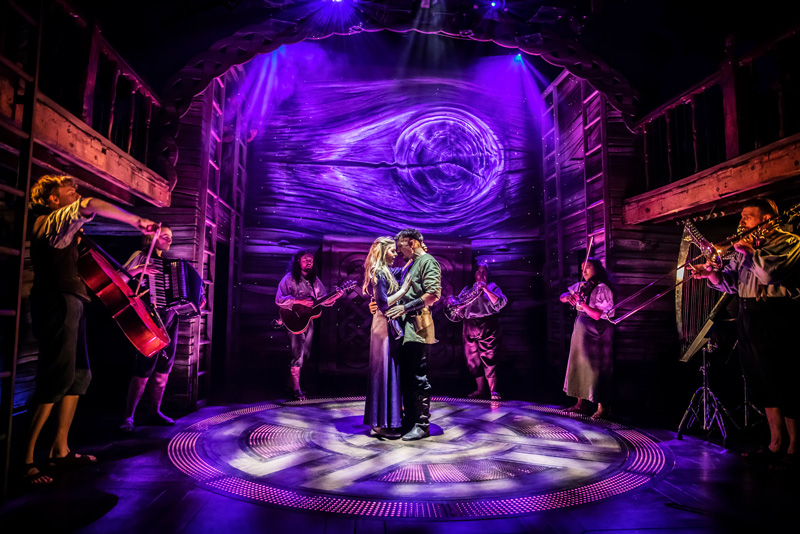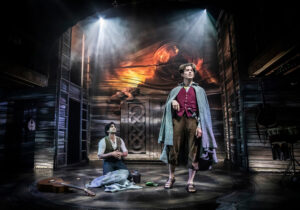
In what’s regarded as one of the most epic fantasy stories ever written, J. R. R. Tolkien’s The Lord of the Rings is a sweeping saga, centered around a hobbit named Frodo, who must undertake a treacherous mission though middle Earth to destroy an evil, magic ring. The literary masterpiece has been reinterpreted numerous times over the years, from cartoons to films to even a West End musical. First performed at Theatre Royal Drury Lane in 2007, the musical was recently revived and reimagined at The Watermill Theatre in Berkshire. The lighting designer for this new production is Rory Beaton who approached White Light (WL) to supply his lighting equipment.
The Lord of the Rings is a story which is undoubtedly familiar to so many. With this in mind, Rory and the rest of the show’s creative team wanted to make their version as unique as possible. He explains: “We were very conscious that, as the first ever non-replica production of the original musical, we wanted to bring something new to the table. As such, we have created a brand new and unique production that takes place both inside the actual theatre itself as well as outside in the beautiful grounds. Our version is about celebrating ‘The Shire’, the story, the phenomenal music and, of course, the beautiful Watermill Theatre. Our aim was to prove you can do big things on the small scale!”.
With a show this ambitious, it naturally meant that Rory had to achieve a significant amount with his lighting design. He comments: “I know this may seem like a stock answer but I really do mean this: there are SO many locations within the show. We start in Bagend, go to Rivendale, Bree, Mordor, Fangorn Forest, Moria, Lothlórien… I could go on! Oh, and there are numerous epic battles chucked in throughout! My main requirement was then to dress and continually re-shape Simon Kenny’s wonderful set. I do this in close collaboration with the fabulous video designer George Reeve – which was a bit of a task for a non-stop three-hour epic! I spent a lot of time trying to crack what those different locations and ‘worlds’ felt like – and not necessarily what people just assume they would be because of the huge film franchise”.

Given his brief, Rory knew that flexibility was going to be a key factor when it came to his rig. He also had to build something that fitted in with The Watermill’s specific layout. He explains: “The Watermill’s fixed grid sits at about 5m from the venue’s floor. Our stage is raised by +300mm or so to allow for various revolves and lifts, etc. With that comes a requirement for fixtures to not hang too low, not obstruct sightlines, not be too noisy and go wide enough to toplight the revolve with one singular unit…. So just a few requirements to consider!”.
All of these factors were raised when Rory approached the WL Customer Service team to discuss his rig and what fixtures he could potentially draw on. He comments: “A vital fixture on this production is the Ayrton Diablo. They were the only theatrical unit I knew of which was compact enough, quiet enough, bright enough and even has shutters! It was my first time using them so I felt like I was taking a slight risk, but they turned out to be a complete triumph and something I will be calling upon time and time again. They do everything from the big one-source key looks in the show to the delicate tungsten-eque front-of-house specials that illuminate people’s faces. I used these in conjunction with the venue’s existing stock of Martin MAC Auras, various LED Pars, ColorSource Profiles and a smattering of conventionals. We also have some Robe 150s hidden in the venue’s slips positions to do all the show’s sidelight”.
Alongside lighting the traditional theatre space, Rory also had to light the venue’s grounds which are part of the show. He explains: “The outdoor element of the production means lighting the beautiful exterior, numerous catering options, a huge circular stage, band-stands, trees, hedges, and a few paths too! For this, I used lots of Chauvet ColorDash IP LED Pars, WL’s outdoor stock of ETC Source Fours, various Parcans and hundreds of meters of festoon”.
Rory also drew on four Viper smoke machines, tens of meters of ducting, a vertical fogger, an MVS Hazer, two micro foggers and a handheld mini-mist.
He comments: “What was interesting about this show is that every single fixture seemed to constantly be in use! If the Diablos are off for a split second, they are then marking for the next cue or the next effect. Also, every unit is multi-purpose – everything works hard for its place in the rig. Whether it’s the domestic warmth of Bagend or the intense red fires of Mount Doom, all the units need to be able to do subtlety and ferocious output in equal measure. To put into context, there’s only 20 moving lights in the rig and between them they use 596 channel focusses!”.
With a show this ambitious, it obviously wasn’t without its obstacles. Rory explains: “Fitting a cast of 20 actor-musicians onto a 6m wide x 4m deep stage was obviously tricky! As was trying to then isolate those performers, highlight the main moments without any followspots and then create location after location! The thing about The Watermill is; where the cast stand and the marks they hit are centimetre precisions. As such, moving half a metre in The Watermill feels like a full metre anywhere else. The level of precision and consistency is totally crucial – and that’s a joint effort between the cast and the creative team.
He continues: “It’s also worth noting that, like so many other venues, during the run-up to this show, The Watermill received a 100 percent cut in their Arts Council England funding, removing them from the ACE portfolio. That meant our budgets have been stricter than ever – with zero room to run over. With this in mind, WL have just been PHENOMENAL with their help and coming up with alternatives and different solutions to fulfil my design. It’s no exaggeration to say that, without their generosity, this show wouldn’t look half of what it now does”.
The Lord of the Rings – The Musical recently opened to critical and audience acclaim. It runs until 15th October 2023.
Project credits:
Produced by The Watermill Theatre in association with Kevin Wallace for KWL & Middle-earth Enterprises.
Lighting Designer: Rory Beaton (www.rorybeaton.co.uk).
Programmer: Jack Ryan.
Production Electrician: Ryan Tate.
Watermill Venue Team: Them Townsend.
Production Shots: Pamela Raith.











